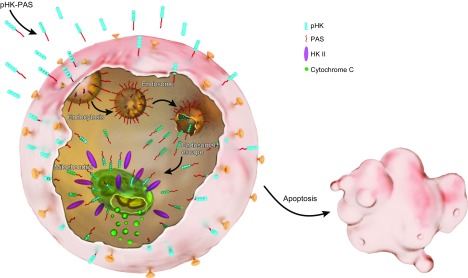Figure 9.
Proposed model of pHK-PAS action. Coupling of PAS to pHK enhances the peptide’s cellular uptake. This uptake occurs by both macropinocytosis and energy-independent mechanisms (translocation across the plasma membrane). In the case of uptake by macropinocytosis, the PAS sequence facilitates escape of the peptide from macropinosomes to the cytosol, whereas translocation provides the peptide with direct access to the cytosol. Once in the cytosol, pHK-PAS accumulates at the mitochondrial membrane, where it binds to VDAC and displaces endogenous full-length HKII in the process. The disruption of the HKII–VDAC interaction leads to ΔΨm depolarization, inhibition of mitochondrial respiration and glycolysis, depletion of intracellular ATP levels, release of cytochrome c, and, finally, apoptosis.

